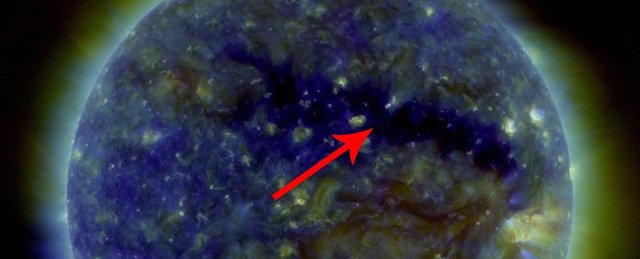The Internet Is Freaking Out Over a "Huge" Solar Storm, So Here's What You Need to Know
You may have seen some buzz about a "massive" or "huge" solar storm about to hit Earth in the days ahead, but there's no need to run for your bunker. Although a geomagnetic storm is coming to the northern hemisphere, it sounds like a pretty mild one.
According to the National Oceanic and Atmospheric Administration (NOAA), a minor geomagnetic storm watch is in effect for March 14 and 15. Meteorologists are predicting a G1-level storm - the lowest level on the solar storm scale, which peaks at G5.
Solar storms often occur when the Sun belches out a flare and a coronal mass ejection (CME). The CME sends a gust of plasma and electromagnetic radiation out into space. If that occurs in Earth's direction, we can see the effects as the charged particles interact with our magnetosphere.
This forecast G1 storm is likely to be caused by a different phenomenon - a coronal hole. These are cooler, less dense regions of plasma and open magnetic fields.
These open structures allow the solar winds to escape more easily, which can blow electromagnatic radiation towards Earth if the hole is in the right position. Such holes are more usually seen during the Sun's less active Solar Minimum, the quiet period of our star's roughly 11-year cycle - which we are currently experiencing.
In fact, right now the Sun is behaving very quietly, reports the British Met Office.
"With no sunspot regions on the visible side of the Sun, solar activity was very low, with no flares observed," the space weather report for the past 24 hours reads.
"No Earth-directed coronal mass ejections were observed."
So what does this G1 storm mean for Earth? Not a lot, actually. There may be some very weak power grid fluctuations caused by small surges of geomagnetically induced current - you probably won't even notice them.
The NOAA also notes that there may be some minor disruptions to satellite operations, such as GPS signals and communications signals.
And if you're far enough north, or perhaps in Antarctica (hi there!), you may get to feast your eyes on the aurora as the charged particles channelled towards the poles by Earth's magnetic field interact with the ionosphere. The NOAA has a very handy 30-minute aurora forecast map.
So no, the power grid isn't going to go out, and neither are the railways, and neither are telecommunications. Everything is absolutely fine, and you can continue to go about your life.
Or as the Met Office puts it, "solar activity is forecast to remain very low over the next four days, with no sunspot regions expected to develop or move onto the visible side of the Sun."

Source
Plagiarism is the copying & pasting of others work without giving credit to the original author or artist. Plagiarized posts are considered spam.
Spam is discouraged by the community, and may result in action from the cheetah bot.
More information and tips on sharing content.
If you believe this comment is in error, please contact us in #disputes on Discord
Hi! I am a robot. I just upvoted you! I found similar content that readers might be interested in:
https://www.sciencealert.com/no-massive-solar-storm-headed-to-earth-march-2018-noaa-g1